Abstract
Harlequin ichthyosis (HI) is a rare and most severe form of autosomal recessive congenital ichthyoses characterized by excessive hyperkeratosis. The skin anomalies affect the shape of eyes, ears, nose, mouth, and distal extremities. Since HI is very fatal, there is a lack of data that documents successful treatment of HI patients with syndactyly. We successfully managed syndactyly in a HI patient by using a conventional method without any complication and we noticed an improvement functionally and aesthetically.
Harlequin ichthyosis (HI, OMIM 242500) is a rare severe form of autosomal recessive congenital ichthyoses and is usually fatal. It is characterized by excessive hyperkeratosis resulting in thick scales separated by deep, erythematous and diamond-shaped fissures in the skin. HI is caused by recessive mutations in the gene encoding the adenosine triphosphate-binding cassette transporter protein ABCA12 (NCBI Entrez Gene 26154). This gene is localized to the lamellar granules of upper epidermal keratinocytes12. ABCA12 plays a key role in keratinocyte differentiation by expressing markers that participate in late epidermal differentiation3. The skin anomalies affect the shape of eyes, ears, nose, mouth and distal extremities45. Syndactyly is one of features shown in HI patient. Syndactyly is one of the most common congenital anomalies of the upper limb6 and several surgical techniques with skin graft has been implemented with great results7. However, surgical outcomes for syndactyly patients with HI are not well known due to the early mortality rate of the patient population. Also, syndactyly in HI patient is associated with skin contracture and consequent angular deformity. Herein, we introduce a case that treats HI patients with syndactyly surgically.
A 6-year-old female patient visited an outpatient clinic with syndactyly in bilateral hand and foot. On physical examination, all the web spaces in hand and foot were involved (Fig. 1). Skin contracture and ulnar deviation of in proximal, middle, distal interphalangeal (IP) joints and metacarpophalangeal (MCP) joint were noted. Also, flexion ontracture, active and passive limitation of extensors were noted in proximal, middle, distal IP joints, and MCP joints (Fig. 2). These features were related to characteristics of HI patient. The patient was unable to grasp objects with her hand despite prolonged physical therapy. To improve her hand function, surgical intervention was determined. The decision was made to perform surgery on the second web space of right hand. A dorsal rectangular flap and a volar triangular flap were designed (Fig. 3). After the division of second and third finger, a dorsal rectangular flap and a volar triangular flap flaps were interposed to recreate the second web. After interposition of flaps, the raw surface was covered with full thickness skin sized 4×2 cm harvested from the left inguinal crease (Fig. 4). Postoperatively, compressive dressing with gauze and an elastic bandage was maintained for 2 weeks. Interposed flaps healed well and full thickness skin grafts were taken perfectly. After 6 months, reconstructed web space was maintained without recurrence (Fig. 5). Six months follow up X-ray image showed significant improvement of ulnar drift. The ulnar deviation angle at MCP joint of second finger corrected from 60 to 25 degree (Fig. 6). In addition, functional improvements were evident by the patient being able to manipulate the joystick of her electric wheelchair and grasp paper money. However, patient underwent minor wound dehiscence in left inguinal donor site, which managed revision and moisturization (Fig. 7).
There is a lack of clinical outcome of syndactyly correction in HI patients. However, longer life expectancy are now achieved with the improvement of care for HI patients5. Since keratinocyte-fibroblast interaction is one of the key steps in wound healing8, dysregulation of epidermal differentiation in HI patients might have negative impact on wound healing. So we concerned of wound healing after surgery. However, functional and aesthetic aspects were improved after surgery. This might suggest that angular contracture of HI patients might be secondary to skin contracture instead of joint problems. So we suggest that adequate release of syndactyly and contracture is important in HI patient. So in HI patients, standard surgical options for syndactyly could be adjustable. In addition, we would like to recommend carefully design the flaps to minimize the raw surface for skin graft due to insufficient skin laxity for full thickness skin donor site. Additionally, one of important postoperative management is moisturizing of recipient and donor site. Moisturizing in HI patients might promote wound healing and contribute to skin contracture release and soften skin scale. Overland and Johnstone9 previously reported hand manifestations of HI patient treated with full thickness skin graft and had no complications. We expect that fullthickness skin graft can be safely performed on HI patient. In conclusion, we successfully managed syndactyly in an HI patient with full thickness skin grafts without any complication and saw improvement functionally and aesthetically.
Figures and Tables
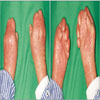 | Fig. 1Preoperative photograph of both hands. Syndactyly of all web space, skin contracture and ulnar deviation of joints are shown. (A) Top view. (B) Bottom view. |
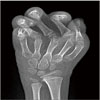 | Fig. 2Preoperative X-ray of right hand. Angle of ulnar deviation of metacarpophalangeal joint of second finger is 60 degree. |
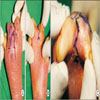 | Fig. 3Photograph of intraoperative design. Zigzag incision, dorsal quadriangular flap and volar triangular flap are drawn. (A) Top view. (B) Bottom view. (C) Tip view. |
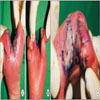 | Fig. 4Immediate postoperative photograph. Right second web space is fully released with full-thickness skin graft. (A) Top view. (B) Bottom view. (C) Tip view. |
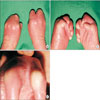 | Fig. 5Postoperative 6-month photograph. Right second web space is well-healed without complication. (A) Top view. (B) Bottom view. (C) Tip view. |
References
1. Kelsell DP, Norgett EE, Unsworth H, et al. Mutations in ABCA12 underlie the severe congenital skin disease harlequin ichthyosis. Am J Hum Genet. 2005; 76:794–803.
2. Akiyama M, Sugiyama-Nakagiri Y, Sakai K, et al. Mutations in lipid transporter ABCA12 in harlequin ichthyosis and functional recovery by corrective gene transfer. J Clin Invest. 2005; 115:1777–1784.

3. Thomas AC, Tattersall D, Norgett EE, O'Toole EA, Kelsell DP. Premature terminal differentiation and a reduction in specific proteases associated with loss of ABCA12 in Harlequin ichthyosis. Am J Pathol. 2009; 174:970–978.

4. Dale BA, Kam E. Harlequin ichthyosis. Variability in expression and hypothesis for disease mechanism. Arch Dermatol. 1993; 129:1471–1477.

5. Rajpopat S, Moss C, Mellerio J, et al. Harlequin ichthyosis: a review of clinical and molecular findings in 45 cases. Arch Dermatol. 2011; 147:681–686.
6. Toledo LC, Ger E. Evaluation of the operative treatment of syndactyly. J Hand Surg Am. 1979; 4:556–564.

7. Vekris MD, Lykissas MG, Soucacos PN, Korompilias AV, Beris AE. Congenital syndactyly: outcome of surgical treatment in 131 webs. Tech Hand Up Extrem Surg. 2010; 14:2–7.

8. Werner S, Krieg T, Smola H. Keratinocyte-fibroblast interactions in wound healing. J Invest Dermatol. 2007; 127:998–1008.

9. Overland J, Johnstone B. Surgical management of the hand manifestations of harlequin ichthyosis. ANZ J Surg. 2018; DOI: 10.1111/ans.14435. [Epub ahead of print].





 PDF
PDF ePub
ePub Citation
Citation Print
Print


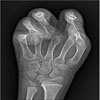
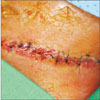
 XML Download
XML Download